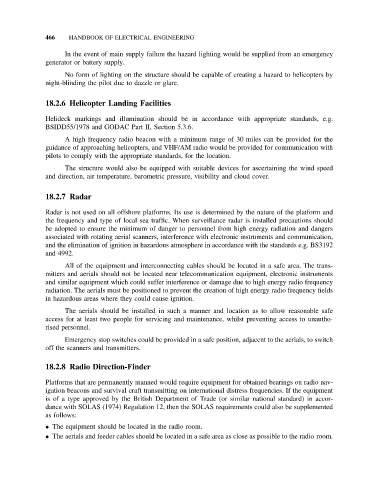Page 477 - Handbook of Electrical Engineering
P. 477
466 HANDBOOK OF ELECTRICAL ENGINEERING
In the event of main supply failure the hazard lighting would be supplied from an emergency
generator or battery supply.
No form of lighting on the structure should be capable of creating a hazard to helicopters by
night-blinding the pilot due to dazzle or glare.
18.2.6 Helicopter Landing Facilities
Helideck markings and illumination should be in accordance with appropriate standards, e.g.
BSIDD55/1978 and GODAC Part II, Section 5.3.6.
A high frequency radio beacon with a minimum range of 30 miles can be provided for the
guidance of approaching helicopters, and VHF/AM radio would be provided for communication with
pilots to comply with the appropriate standards, for the location.
The structure would also be equipped with suitable devices for ascertaining the wind speed
and direction, air temperature, barometric pressure, visibility and cloud cover.
18.2.7 Radar
Radar is not used on all offshore platforms. Its use is determined by the nature of the platform and
the frequency and type of local sea traffic. When surveillance radar is installed precautions should
be adopted to ensure the minimum of danger to personnel from high energy radiation and dangers
associated with rotating aerial scanners, interference with electronic instruments and communication,
and the elimination of ignition in hazardous atmosphere in accordance with the standards e.g. BS3192
and 4992.
All of the equipment and interconnecting cables should be located in a safe area. The trans-
mitters and aerials should not be located near telecommunication equipment, electronic instruments
and similar equipment which could suffer interference or damage due to high energy radio frequency
radiation. The aerials must be positioned to prevent the creation of high energy radio frequency fields
in hazardous areas where they could cause ignition.
The aerials should be installed in such a manner and location as to allow reasonable safe
access for at least two people for servicing and maintenance, whilst preventing access to unautho-
rised personnel.
Emergency stop switches could be provided in a safe position, adjacent to the aerials, to switch
off the scanners and transmitters.
18.2.8 Radio Direction-Finder
Platforms that are permanently manned would require equipment for obtained bearings on radio nav-
igation beacons and survival craft transmitting on international distress frequencies. If the equipment
is of a type approved by the British Department of Trade (or similar national standard) in accor-
dance with SOLAS (1974) Regulation 12, then the SOLAS requirements could also be supplemented
as follows:
• The equipment should be located in the radio room.
• The aerials and feeder cables should be located in a safe area as close as possible to the radio room.

